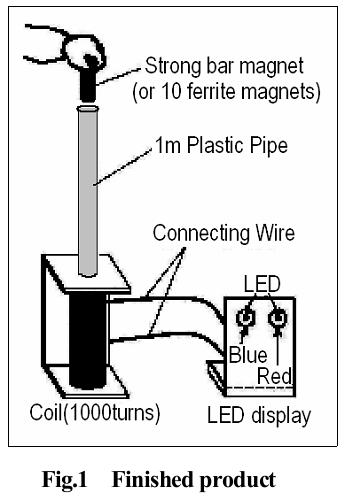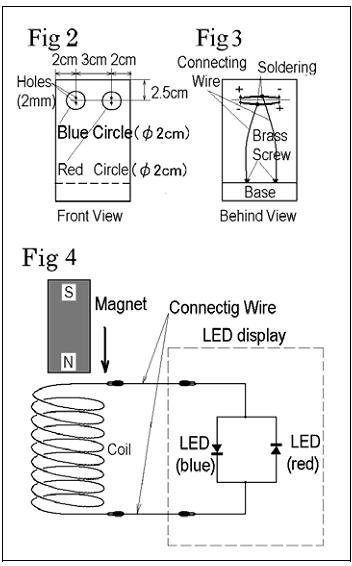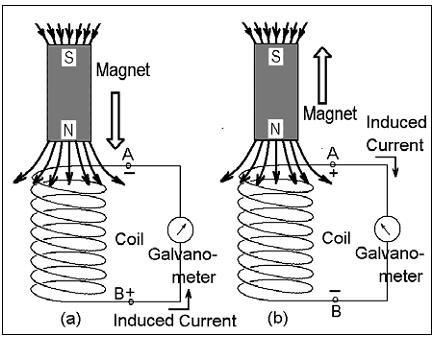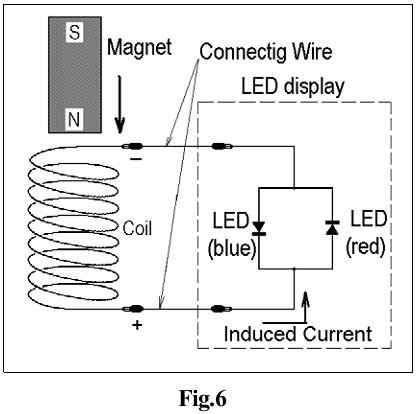makes electricity by shaking magnets
 |
makes electricity by shaking magnets |
Project Name
Simplest homemade electrical generator lights a LED or makes electricity by shaking magnetsExperiment Level: Secondary Class
Concept:
Induced electromotive force lights a LED.
Introduction:

A changing magnetic flux through a coil induces a current in the coil. The phenomenon is called electromagnetic induction and it was discovered by Michael Faraday in England in 1831. It is one of the most important phenomena in physics and in practical use. It needs a galvanometer, a strong magnet and a coil which has enough turns to demonstrate the phenomenon to students. Sadly a galvanometer is a little expensive and difficult to find. However a good demonstration of the phenomenon can be done using strong bar magnet and a LED display instead of a galvanometer.
Materials:
- two red LED (transparent type)
- a piece of plywood (size 7 cm×15 cm, thickness 5 mm)
- wood base (7 cm×6 cm×1 cm)
- 2 brass screws
- 2 connecting wires (length 20 cm)
- a coil (about 1000turns)]
- strong bar magnet / ten ferrite magnets
- a plastic pipe (diameter 25 mm, length 1 m)
- two connecting wires with crocodile clips

Construction:
- Draw a blue circle and a red circle on the plywood and make 4 holes for two LED as shown in Fig.2.
- Attach the plywood to the wood base using wood glue and fix two brass screws on the base as shown in Fig.3.
- Paint two LED blue and red using permanent markers.
- Attach 2 LED to the holes of the plywood and wire them using soldering iron as shown in Fig.3.

Working:
- Arrange the equipments as shown in Fig.4.
- Put the coil on a table vertically and fill the bottom of the coil hole with tissue.
- Put the plastic pipe on the top of the coil hole vertically.
- Fall the bar magnet from the top of the plastic pipe.
- One of the LED will be switched on.
- Put the magnet upside down and try again. The other LED will be switched on.

Science:
In 1831, Michael Faraday discovered that an electromotive force is induced in a coil when the
magnetic flux passing through the coil increases or decreases. This process is called electromagnetic induction. Faraday’s law says: The magnitude of the induced electromotive force is proportional to the rate at which the magnetic flux passing through the coil changes.
Lenz’s law says: The direction of the induced current is that it sets up a magnetic field that tends
to stop the cause producing it. As shown inFig.5, there is a coil and its ends are connected to a galvanometer. (a) In the case that the north pole of the bar magnet moves into the coil As the magnetic flux passing through the coil is increasing, the current induced in the coil sets up
a magnetic field that decreases the flux. So, the induced current flows as shown in Fig.5 (a).
(b) In the case that the north pole of the bar magnet withdraws from the coil as the magnetic flux passing through the coil is decreasing, the current induced in the coil sets up a magnetic field that increases the flux. So, the induced current flows as shown in Fig.5 (b). When you connect the LED display to the ends of the coil and fall a bar magnet from 1m height as shown in Fig.6, what will happen? In this case, the red LED will be switched on, because this case is same as that of Fig.5 (a).
Put the magnet upside down and try again. This time, the blue LED will be switched on.
Things to do:
1. Consider the reason why you must fall a magnet from high place.2. Try to demonstrate the experiment using a galvanometer instead of the LED display.
Source: http://www.paksc.org/pk/science-experiments/item/1029-simplest-homemade-electrical-generator-lights-a-led.html




There are a lot of full-color images, with thorough information of every factor of wood managing venture such as outstanding furniture applications.....
ReplyDeleteThere is our web page for more details about our wood operating project check out here.
woodwork
woodworking
woodworking plans
woodworking projects